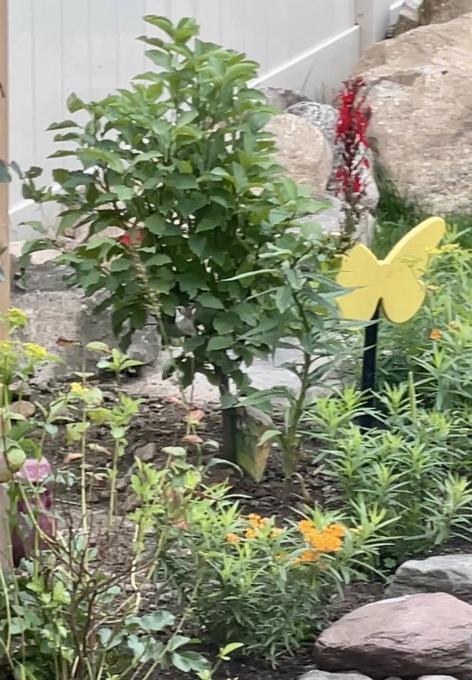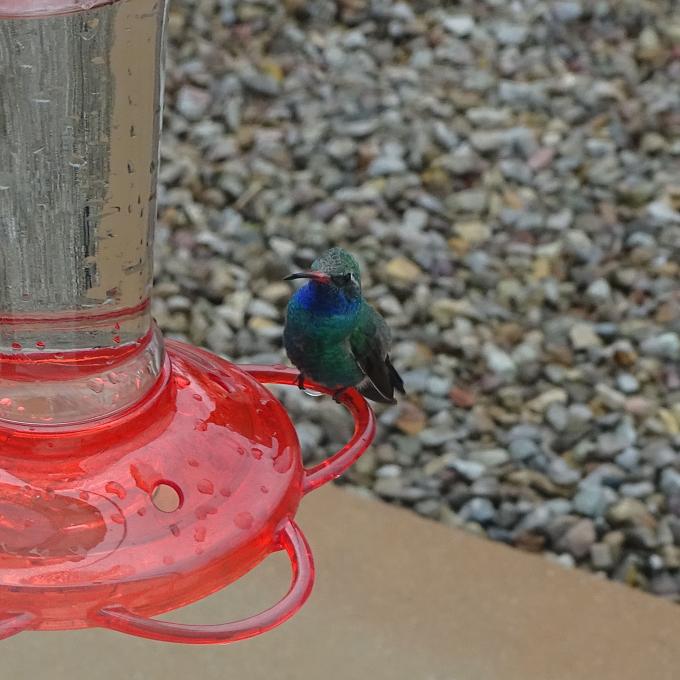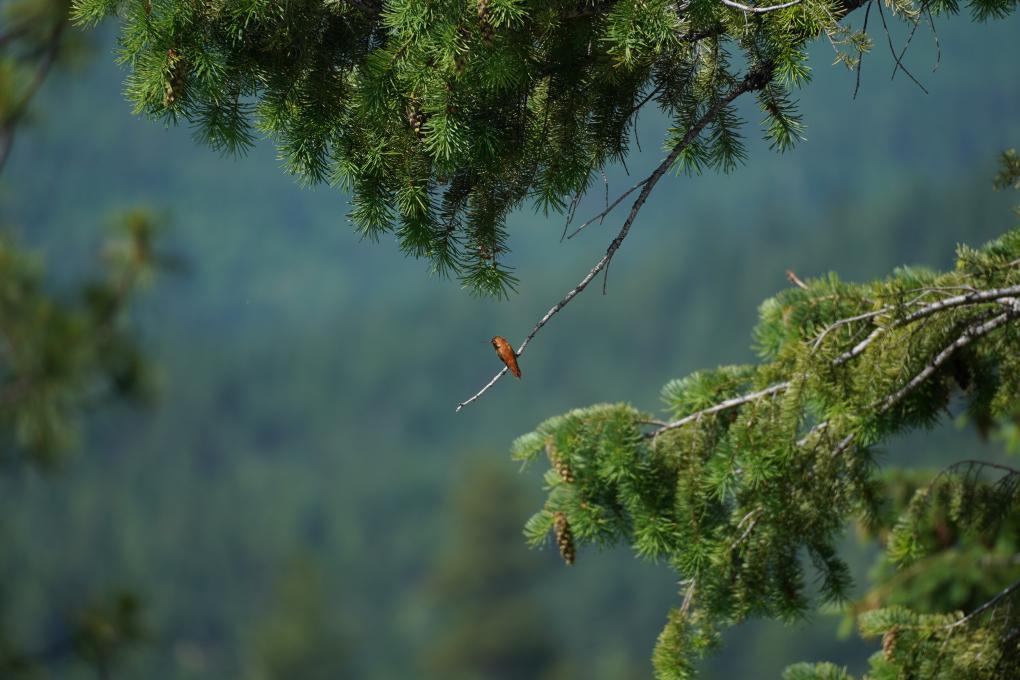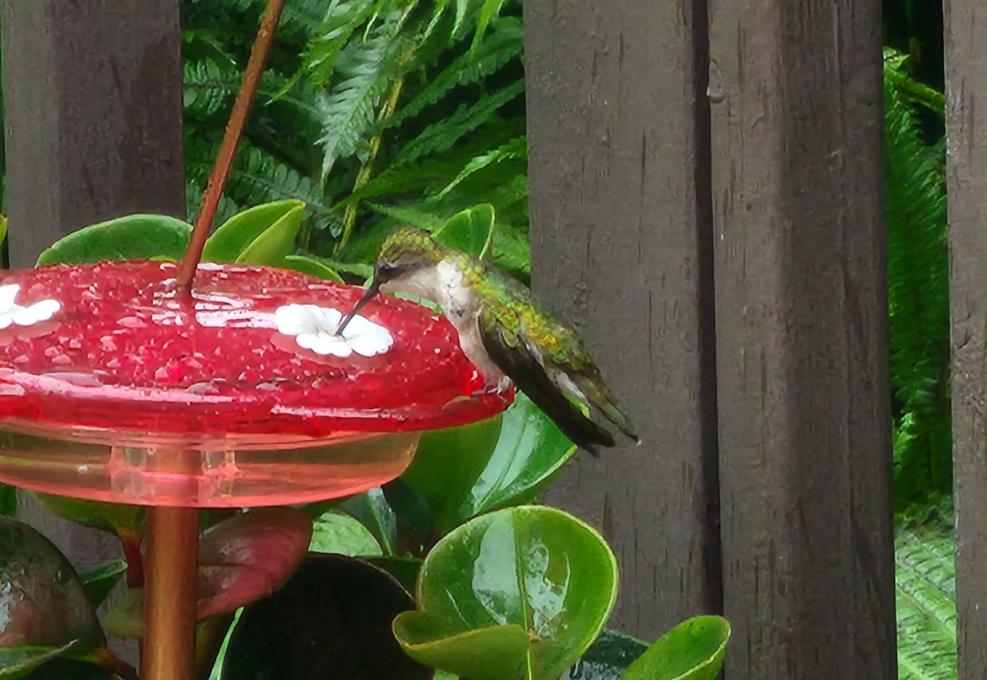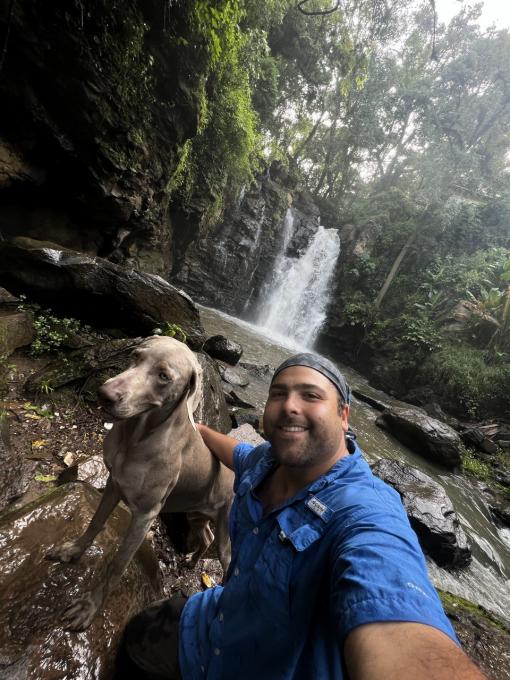The Cornell Lab Bird Academy › Discussion Groups › The Wonderful World of Hummingbirds › What Makes a Hummingbird a Hummingbird
-
I was lucky enough to take a guided trip to SE Arizona during monsoon season this past August. We saw 14 species of hummingbirds, my favorite was the Berryline with its brilliant green head. It was really fun going to different feeders either at parks or preserves or where people let you go in their backyard to wait for birds. Waiting one day a Coopers Hawk swept in but left without catching anything.
-
I am fortunate to live in southern California and have Allen's, Anna's, Costa's regularly come to my feeders. I have even had a Black-chinned on occasion. I have several feeders, spread out, because one of the Allen's Hummingbirds is quite a defender of the food source.
-
We had a female Ana's Hummingbird make a nest in our courtyard for years and it was always fun seeing her year after year. Sometimes she would have two nests in a season! She'd always divebomb John, my second dad since he's taller than Mom and I, whenever he'd be heading to the front door, though.
-
Ruby throated hummingbirds are frequent visitors to my blueberry bushes which are right outside my dining room window. I love to watch them while I eat.
-

 I live in Northeastern U.S. where we only have Ruby-throated hummingbirds. I never get tired of watching them! It's sad when they head south in late summer, but always exciting when they return in the spring. They always come around looking for the feeder before I put it out. It's fascinating to watch the males courting the females, but I've never found a nest.
I live in Northeastern U.S. where we only have Ruby-throated hummingbirds. I never get tired of watching them! It's sad when they head south in late summer, but always exciting when they return in the spring. They always come around looking for the feeder before I put it out. It's fascinating to watch the males courting the females, but I've never found a nest. -
Is that a male ?
-
-
I have been into hummingbirds for a few years and have gone to festivals in Rockport, Texas and Sedona ,Arizona. Now I am living in Mexico City and I see many berry linea or berry line hummingbirds here more than another species. I cant believe how in a city this big theses bird found a way to live and survive.
-
Oh, yes. Rufous HU make it up here (58 N). And we often have at least one pair all summer in our blueberry and moss understory to hemlock and spruce Most memorable is my week in Costa Rica with Operation Rubythroat. Active participation in running mist nets and banding I remember the vigorous Cinnamon Stars
-
 This summer I had the privilege of watching a Ruby-throated nesting in the woods behind our deck, from the building of the nest until it’s abandonment after use. We live in northeastern Pennsylvania. This is a digi-scoped picture of the two nestlings the day before they fledged.
This summer I had the privilege of watching a Ruby-throated nesting in the woods behind our deck, from the building of the nest until it’s abandonment after use. We live in northeastern Pennsylvania. This is a digi-scoped picture of the two nestlings the day before they fledged. -
Yes! We have a hummingbird feeder that we haven't seen birds at for a couple of years, but this year there have been two juveniles visiting daily for a couple of weeks :)
-
Yes! I saw my first hummingbirds this summer at a public butterfly garden maintained by the Bergen County Audubon Society, and, inspired by them, I planted my own hummingbird garden in my yard. So far I have seen a hummingbird on three separate visits to my cardinal flowers after only a few weeks! I believe my hummingbird is a female Ruby-throated.

-
I have seen many hummingbirds in the places I've lived and visited, mostly near gardens or feeders. But the most enchanting sightings have been when I am backpacking, sitting at the top of a mountain pass, when suddenly I get investigated by a hummingbird! I have been in the Sierras, on top of Pinchot and Mather passes, and had hummingbirds close up, checking me out eye to eye. I recently was in the Bob Marshall Wilderness near the Chinese Wall, and a hummingbird visited our group of three while we were having dinner, flying right into the circle and looking at us each in turn. These were all such a surprise! Such odd behavior checking out the humans.
-
Here in the Sonoran Desert (Southern Arizona), I've seen mostly Anna's, Allen's, Costas and Broadbills (photo) at my feeders. Recently, several aggressive Rufous have laid claim to my primary feeder. So far, they've been too fast to photograph. They attempt to intimidate the others, but many are brave enough to fight back or simply sit in the nearby trees until the bullies leave. Enjoying this course!

-
A few years ago my wife and I took a bird tour to Cuba. We were lucky enough to see several hummers including the Bee Hummingbird, which was our grail bird for the trip.
-
Hi Dough. How can I find out about hummingbird trips like u did? Carmela
-
-
I live in the SF Bay area. We commonly have Ann'a at our feeder's and occasionally see Allen's and Rufous in the area. Recently saw Rufous in Alaska. My first experience with a hummingbird was at a friend's house in La Jolla, near San Diego., let alone differentiate We were able to corral it and get it outside unharmed. This was long ago and none of us even knew about different species. A number of years ago my wife and I were at a desert zoo near Palm Springs. My wife was wearing a bright red shirt with a flower print. Not sure of the species but i think it was a Costa's. It approached my wife's shirt as if to feed at the flowers but it realized its mistake and buzzed off.
-
I live in Australia. We have all manner of gorgeous birds, but sadly, no little hummers. When I visited Vancouver and the Rockies a couple of years ago, I was enchanted to see them for the first time. They were visiting a brightly coloured feeder hanging outside the restaurant where we were having lunch. We became the entertainment as we expressed our delight!
-
I live in NW Montana. The rufous control most of the feeders but calliope and black-chinned make an occasional appearance. I have one male rufous who has a favorite perch on a tree high up where he can keep an eye on his area. He even gets upset when other birds (especially juveniles) just stop by to perch. The young birds don't know why this hummingbird is so upset. It's quite funny to watch.


-
The ruby throated hummingbird visits my blueberry bushes here in New York State. I don't put out feeders because of the bear.
-
Living in Minnesota, I generally see only ruby-throated hummingbirds, but watching their acrobatics and battles is always a delight. Once on a trip to Arizona, I was lucky enough to see a male Anna's hummingbird performing his dive/"chip" display. And many years ago, I traveled to Costa Rica and saw ten species of hummingbirds, including the purple-throated mountain-gem, green-breasted mango, white-necked jacobin and the stunning violet sabrewing. To think that there are over three hundred species out there! I hope there are many more hummingbirds in my future.
-
This is my "resident" Ruby-Throated hummingbird, who visits the backyard every year. I call him "Monsieur" -something about his colorful elegance brings up the nickname in my mind!-, but I know there is more than one, and can sometimes recognize a "Madame", with no red gorget. Probably the case in this photo. Their presence in our garden is so joyful, and we enjoy seeing them visiting the feeders, perching in nearby branches, or chasing each other. Once I was witness to a courtship dance, which was amazing. I'm very proud of my summer visitors!

-
I live in wine country near Niagara Falls Ontario and it is only in the last couple of years that my wife and I became interested in hummingbirds.We no longer have a garden but we have balcony.Flowers and a couple of feeders soon brought them around.Their evening feeding time coincides with ours so we often sit with our field glasses and get a front row seat.I understand these will be Ruby Throated hummingbirds.Supper often goes cold.Wonderfull to watch.
-
I live in Valle de Bravo in the state of Mexico. There is many species of humingbirds in these mountains. Most of my encounters with these wonderful creatures have been with the species Basilinna leucotis, the white eared hummingbird. They come arround often to feed on the many flowers in the garden and it is lovely to see them. Tino(my dog) is trained to leave the birds alone and he loves to go birdwatching with me.

-
Love yr dog!
-
-
I have seen the Broad-billed, Glittering Throat in the Emerald category , also the Rufous and Anna Hummingbirds in the Bee category. So beautiful. I am unable to find the pictures taken of these Hummingbirds in San Bernardino County California. The pictures were taken at a backyard feeder. Thank you for the presentation on the iridescence. Ruth Bates
-
I have to say that I own the Princeton guide to Hummingbird so I am familiar with many of the topics covered in the first part of this course. But having an animated explanation of how iridescence works is extremely useful. It works better, I think, than static images on a page. It also helps explain why some hummers are just so vivid, amazing!
-
On the East Coast only the Ruby Throated Hummingbirds come and visit my garden and my feeder. However, when we winter on the Pacific Coast we often see Anna's and an occasional Rufus or Allen passes through. I would love to see a Calliope.
-
I think a little Anna's just came to inspect me as I sit here in my garden watching this course in Los Angeles, CA.
Read More:

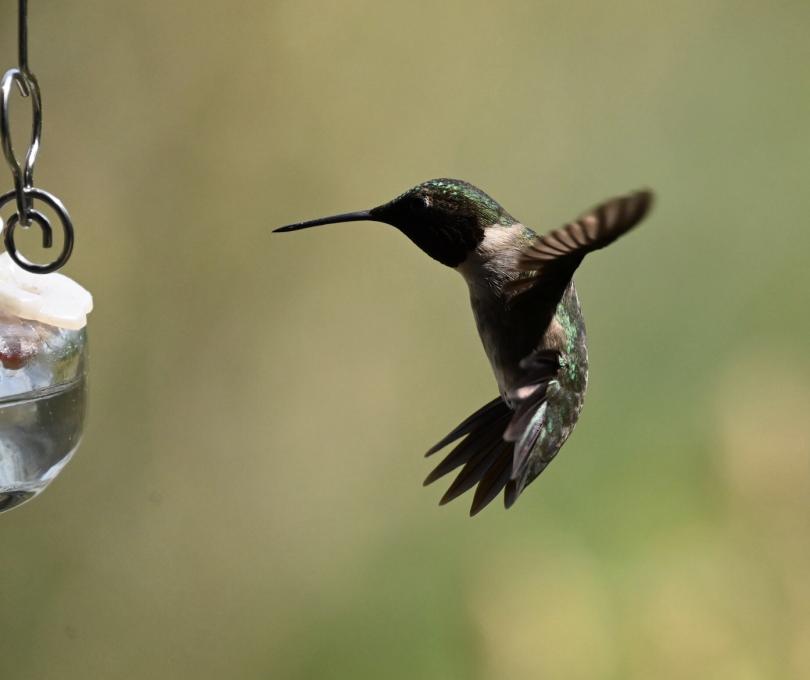 I live in Northeastern U.S. where we only have Ruby-throated hummingbirds. I never get tired of watching them! It's sad when they head south in late summer, but always exciting when they return in the spring. They always come around looking for the feeder before I put it out. It's fascinating to watch the males courting the females, but I've never found a nest.
I live in Northeastern U.S. where we only have Ruby-throated hummingbirds. I never get tired of watching them! It's sad when they head south in late summer, but always exciting when they return in the spring. They always come around looking for the feeder before I put it out. It's fascinating to watch the males courting the females, but I've never found a nest. 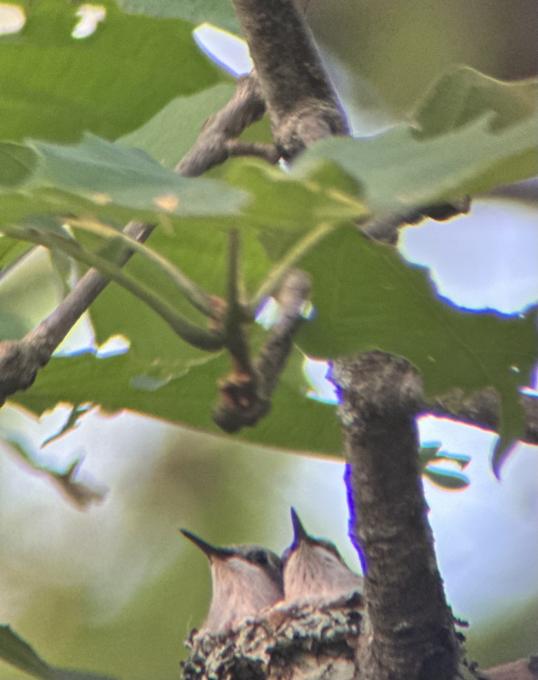 This summer I had the privilege of watching a Ruby-throated nesting in the woods behind our deck, from the building of the nest until it’s abandonment after use. We live in northeastern Pennsylvania. This is a digi-scoped picture of the two nestlings the day before they fledged.
This summer I had the privilege of watching a Ruby-throated nesting in the woods behind our deck, from the building of the nest until it’s abandonment after use. We live in northeastern Pennsylvania. This is a digi-scoped picture of the two nestlings the day before they fledged. 